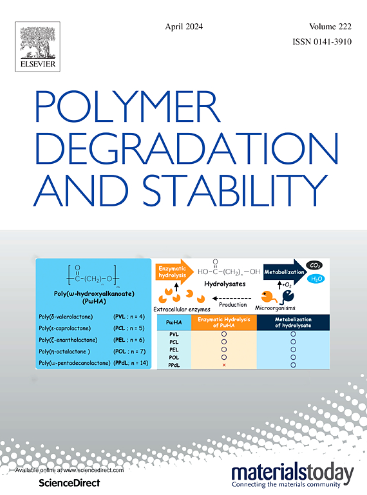Fluorescent starch/chitosan composites as safe and photoprotective coverings for perishable food products
IF 6.3
2区 化学
Q1 POLYMER SCIENCE
引用次数: 0
Abstract
Perishable product quality and shelf life (e.g., fresh fruit and vegetables) may be partially controlled process by employing intelligent packaging. Protecting food from light, which quickly initiates food spoilage, prompting its chemical, enzymatic, and physical modification, plays a crucial role in packaging functions. In the present research, environmentally safe starch-chitosan films enriched with dialdehyde starch and fluorescent dyes (fluorescein/Rose Bengal) exhibiting UV radiation absorption properties were designed. Such networks formed of biopolymers and fluorescein/Rose Bengal may limit direct 1O2 attacks. The starch changes its crystallinity degree (Xc) from 17.4 % in starch film, to 19.6 % for starch-chitosan (SCh) film and 26,4 % for starch-chitosan-dialdehyde starch (SChDS) mixture. When modified with dyes its maximal drop was 13.9 % (Starch/chitosan/dialdehyde starch/Rose Bengal film; RSChDS), and the increase to 24 % for starch/chitosan/dialdehyde starch/fluorescein film (FSChDS) was observed. Mixtures with fluorescein were more resistant to bending than those with Rose Bengal. SEM images demonstrate good structural integrity of the samples (with the exception of starch/chitosan/ Rose Bengal film, RSCh). Spectroscopic studies (UV–Vis, FTIR-ATR, Raman, XRD, NMR) confirmed the interaction between blend components (covalent, ionic, and hydrogen bonding). Competitive oxidation reactions, chromophore formation, dye photolysis, and conformational changes of starch were observed after prolonged UV-light irradiation. The type of dye and irradiation insignificantly modify the thermal resistance of the samples. UV-light influenced increased surface roughness of the FS and FSChDS samples, and the opposite effect (smoothing the surface) for RS and RSChDS blends. Dialdehyde starch (DS) promoted cross-linking between the mixture components. It improved the flexibility of the films (most in the case of samples with fluorescein) but also limited the susceptibility to UV radiation. Coatings of starch/chitosan/dialdehyde starch/fluorescein (FSChDS) appear to be good blockers for sunlight, protecting food products against accelerated spoilage. Such coatings may be applied to the broadly understood packaging industry for light-sensitive and perishable food, cosmetics, and medicine products, such as lipids and vitamins, to protect against UV radiation and the influence of microorganisms.
荧光淀粉/壳聚糖复合材料作为易腐食品的安全光保护覆盖物
易腐产品的质量和保质期(如新鲜水果和蔬菜)可以通过采用智能包装部分控制。保护食品不受光线的影响在包装功能中起着至关重要的作用,光线会迅速引发食品变质,促使其进行化学、酶和物理改性。本研究设计了富含双醛淀粉和荧光染料(荧光素/孟加拉玫瑰)的环境安全的淀粉-壳聚糖膜,具有紫外辐射吸收性能。这种由生物聚合物和荧光素/玫瑰红形成的网络可能限制直接的o2攻击。淀粉的结晶度(Xc)从淀粉膜中的17.4%变化到淀粉-壳聚糖(SCh)膜中的19.6%和淀粉-壳聚糖-双醛淀粉(SChDS)混合物中的26.4%。淀粉/壳聚糖/双醛淀粉/玫瑰孟加拉膜改性后,其最大降幅为13.9%;淀粉/壳聚糖/双醛淀粉/荧光素膜(FSChDS)提高24%。含有荧光素的混合物比含有孟加拉玫瑰的混合物更能抵抗弯曲。SEM图像显示样品具有良好的结构完整性(淀粉/壳聚糖/玫瑰孟加拉膜,RSCh除外)。光谱研究(UV-Vis, FTIR-ATR, Raman, XRD, NMR)证实了混合组分(共价键,离子键和氢键)之间的相互作用。在长时间的紫外光照射下,观察了淀粉的竞争性氧化反应、发色团形成、染料光解和构象变化。染料种类和辐照对样品的热阻影响不显著。紫外光影响FS和FSChDS样品表面粗糙度的增加,而RS和RSChDS混合物的效果相反(平滑表面)。双醛淀粉(DS)促进了混合物组分之间的交联。它提高了薄膜的柔韧性(大多数是荧光素样品),但也限制了对紫外线辐射的敏感性。淀粉/壳聚糖/双醛淀粉/荧光素(FSChDS)涂层可以很好地阻挡阳光,防止食品加速变质。这种涂层可以应用于广泛理解的包装工业,用于光敏和易腐食品,化妆品和药品,如脂类和维生素,以防止紫外线辐射和微生物的影响。
本文章由计算机程序翻译,如有差异,请以英文原文为准。
求助全文
约1分钟内获得全文
求助全文
来源期刊

Polymer Degradation and Stability
化学-高分子科学
CiteScore
10.10
自引率
10.20%
发文量
325
审稿时长
23 days
期刊介绍:
Polymer Degradation and Stability deals with the degradation reactions and their control which are a major preoccupation of practitioners of the many and diverse aspects of modern polymer technology.
Deteriorative reactions occur during processing, when polymers are subjected to heat, oxygen and mechanical stress, and during the useful life of the materials when oxygen and sunlight are the most important degradative agencies. In more specialised applications, degradation may be induced by high energy radiation, ozone, atmospheric pollutants, mechanical stress, biological action, hydrolysis and many other influences. The mechanisms of these reactions and stabilisation processes must be understood if the technology and application of polymers are to continue to advance. The reporting of investigations of this kind is therefore a major function of this journal.
However there are also new developments in polymer technology in which degradation processes find positive applications. For example, photodegradable plastics are now available, the recycling of polymeric products will become increasingly important, degradation and combustion studies are involved in the definition of the fire hazards which are associated with polymeric materials and the microelectronics industry is vitally dependent upon polymer degradation in the manufacture of its circuitry. Polymer properties may also be improved by processes like curing and grafting, the chemistry of which can be closely related to that which causes physical deterioration in other circumstances.
 求助内容:
求助内容: 应助结果提醒方式:
应助结果提醒方式:


